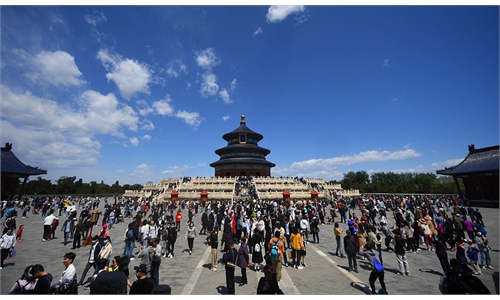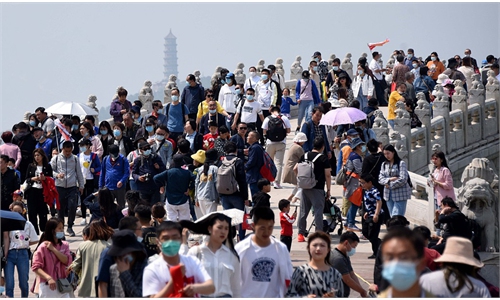GT Voice: China's explosive holiday spending boosts confidence
GT Voice: China’s explosive holiday spending boosts confidence

May Day holiday Photo:VCG
The May Day holiday has once again demonstrated China's rapid economic recovery, with an explosive spending spree lifting many sectors across the country to pre-epidemic levels. Such strong momentum has not only injected new vitality into the Chinese economy but also strengthened the country's confidence and ability to deal with rising challenges at home and abroad.
During the holiday, 265 million passenger trips were expected to be made, up 120.1 percent year-on-year and rising close to the number in 2019 before the COVID-19 pandemic. That includes 106 million passenger trips on the country's railway system, up 0.8 percent from the pre-pandemic level in 2019.
The travel rush also led to a consumption boom in many sectors, including tourism, dining, retailing and other leisure activities. On the first two days alone, transaction volume on China UnionPay network reached 754.3 billion yuan ($116.54 billion), an increase of 5.5 percent compared with the same period last year and up 6.9 percent from the 2019 level.
The holiday spending spree may serve as a microcosm of China's economic resilience and post-epidemic consumption recovery, which observers generally attributed to the "retaliatory spending" after the successful control of the resurgence of the coronavirus.
By comparison, much of the world is still stumbling through pandemic woes, with uneven recovery pace amid global anti-epidemic efforts. Some economies, after recording sharp declines last year, are bound to see strong rebound this year, while others like India may still face an extremely uncertain recovery trajectory as their domestic epidemic situation worsened.
In this context, the Chinese economy, which was the only major economy with positive growth last year, continues to show outstanding resilience with the strong recovery momentum. In the first quarter of this year, China's GDP grew by a record 18.3 percent year-on-year, marking a drastic turnaround from the same period last year when the economy suffered under the impact of the COVID-19 epidemic. It is widely expected that China's GDP will extend the rapid growth in the coming quarter.
Nevertheless, it should also be pointed out that the Chinese economy will continue to face a series of internal and external challenges. Domestically, many economists believe that the growth rate of China's GDP may slow down in the second half of this year as the country's economic transformation toward a high-quality growth model will enter a tough phase and elicit headwinds.
Externally, the US has spared no efforts in pushing its allies to pile pressure on China continuously over a series of issues with the ultimate aim of containing China's development. Just as hundreds of millions of people in China hit the road and enjoyed their holidays, officials from the US and its so-called G7 allies were meeting in London to discuss ways to contain China. That will undoubtedly create certain risks and uncertainties for the future prospect of the Chinese economy.
Under such circumstances, the vitality and resilience of the Chinese economy, which is reflected by the record-setting May Day holiday spending, is the source of confidence in China's comprehensive capability to deal with any challenge. As long as China keeps the virus under control and retains the economic vitality for further growth, it will be able to overcome any internal and external hurdles that might arise, not matter how hard some in the West try to make them.



